One of the main collateral damage of wars is the destruction of historical and artistic heritage. Despite the precautions taken to protect the monuments -let us remember that emblematic image of La Cibeles covered with sandbags-, bombardments or fire sometimes deteriorate, if not completely eliminate, the vestiges that had survived centuries and even millennia -see the example of Pompeii-; in some cases, when they had just been discovered by archaeologists. This is what happened, for example, with the two colossal palace-ships that Emperor Caligula used to navigate Lake Nemi.
It is not the first time that we talk about giant ships in ancient times; let's remember the articles dedicated to Syracusia , designed by Archimedes for the tyrant Hiero II of Syracuse, or al tessakonteres , the enormous catamaran of Ptolemy IV. In fact, Caligula was inspired by both to become infatuated and also have his own, although he was not satisfied with one and had two made. They were different, yes, because if the first was dedicated to religious functions, the second, the largest, was a sumptuous floating residence.
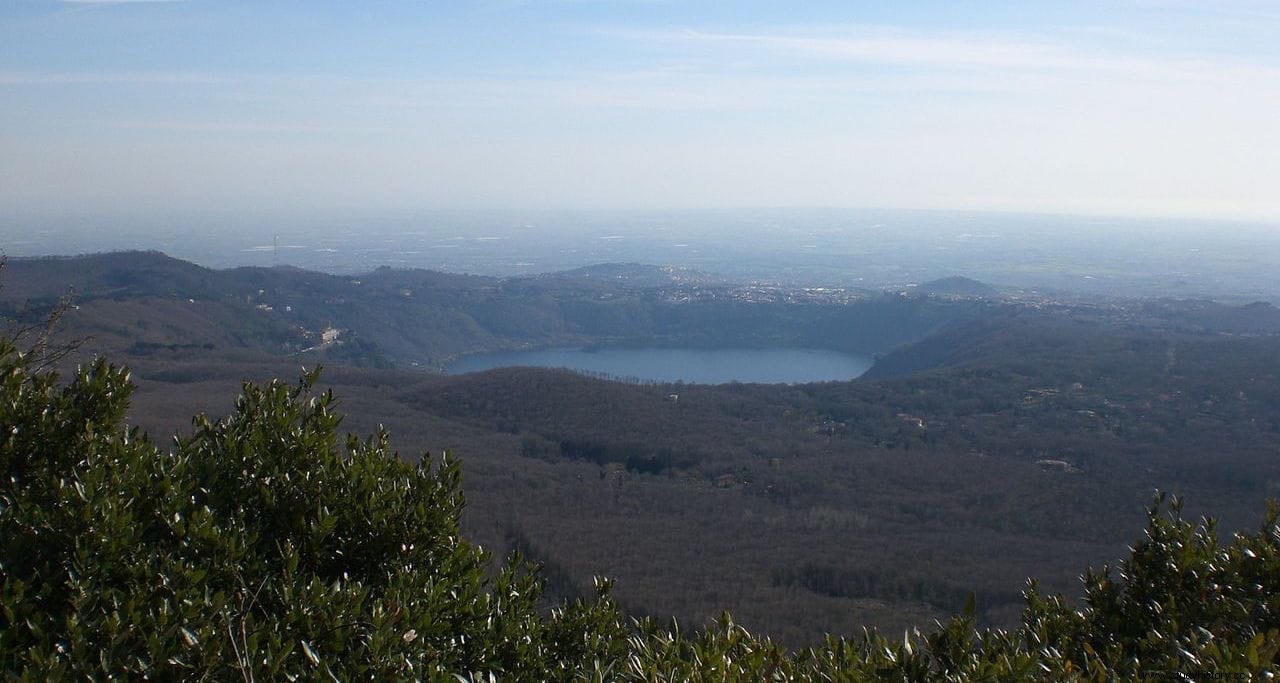
Moreover, the bibliography of the fifteenth century tells us that a third vessel was made, not yet found and, therefore, an object of desire for any archaeologist. Apparently, since 2017 Lake Nemi has been scoured for that missing wreck; If the other two appeared, why wouldn't the one who completes the trio do it? It has the advantage that the Nemi, having its origin in a volcanic caldera, is relatively small, with just over 167 hectares of surface and a maximum depth of 33 meters.
Before these last data the strangeness automatically arises:why did the emperor want three boats like that in a tiny lake? The probable answer is that it is very close to Rome, some thirty kilometers away, and was of a sacred nature; so much so that, according to Pliny the Younger , it was forbidden to navigate its calm waters except for religious reasons, as it was dedicated to Diana Nemorensis, a syncretic goddess between the Latin Diana (assimilated from the Hellenic Artemis) and the Egyptian Isis.
The cult of this last divinity had established itself strongly in Rome, where there was no major problem in accepting foreign pantheons, although they often merged with the local ones and in this case it was born Diana montium custos nemoremque virgo (guardian of the mountains and virgin of Nemi). A Latin myth says that it was Orestes, the son of Agamemnon and Clytemnestra, who had fled with his sister Iphigenia to the Italic region of Aricia, who introduced the cult of Diana; more specifically Diana Táurica, to whom human sacrifices were originally made, although they were later banned.
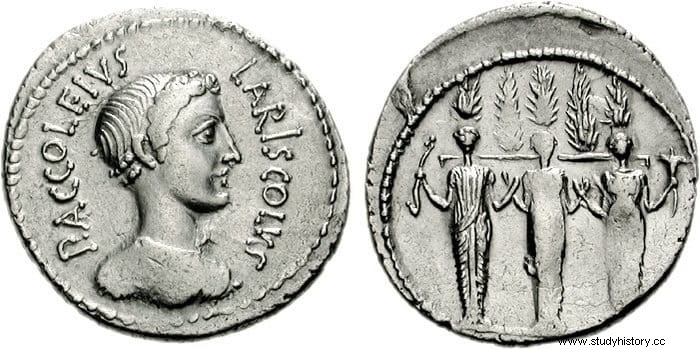
Another legend, which comes to us from Pausanias in his Description of Greece , says that it was Hippolytus, the son of Theseus, resurrected by Asclepios, who traveled to Aricia, became king and built a temple in honor of Artemis whose priest had to win the position by winning in single combat. The really curious thing is that free men could not participate, leaving the thing reserved for escaped slaves. Hippolytus, by the way, would be deified as Virbius.
Consequently, the cities around the lake, such as Genzano or Aricia (Nemi did not exist in Roman times), worshiped Diana Nemorensis, whose temple was also located nearby, surrounded by a sacred forest and directed by a priest known as Rex Nemorensis . Strabo, in his Geography , confirms that there was a barbarian tradition imported by which, whoever wanted to access that priestly position had to previously kill the Rex Nemorensis headline, hence he was always armed. Suetonius, in Life of the Twelve Caesars , accuses Caligula of confirming that custom.
In mid-August, Lake Nemi hosted the celebration of the Nemoralia, a religious festival in which, according to the description left by Ovid, torches were carried in a procession from Rome and placed on the shore and then garlands of flowers were thrown, votive offerings and fruits to the water from boats. It was a holiday that exempted even slaves from work and that Christianity later assimilated to Assumption Day.
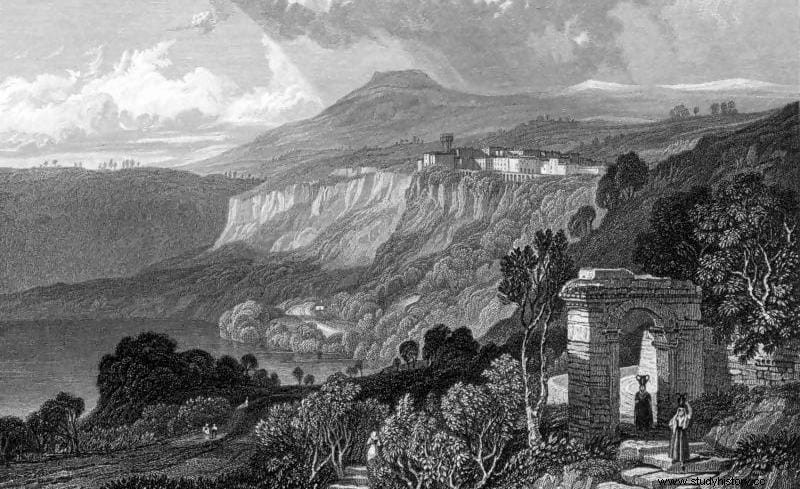
This sacred character of the place had an extra for the wealthy Roman classes:the tranquility and the fact that the summer temperatures were cooler than those of the capital, as a kind of microclimate originated under the crater walls, which promoted many patrician families to settle there for the duration of the summer. But it is that, in addition, during that season an interesting phenomenon took place:the full moon was reflected on the surface of the water, as illustrious visitors such as Goethe or Lord Byron attested, hence the Nemi was called Speculum Dianae (Mirror of Diana) and the emperors came to imbue themselves with the vital energy that emanated.
Caligula decided that instead of building a villa on the shore he would build it on the lake itself and thus launched what experts later cataloged as Nave Seconda (for being the second discovered), 73 meters long by 24 wide. It was a true floating palace with buildings at the bow and stern decorated with marble, mosaics, bathrooms, water pipes and even gardens with trees. This superstructure, which imitated the layout of the sanctuaries dedicated to Isis, was never found but its existence is deducible from the characteristics of the beams and frames, as well as the ballast.
The other ship, First Ship , measured 70 meters long by 20 wide and had the originality of not being fusiform but wider at the stern, probably because the main section was located there:two buildings, one on each rail, connected by stairs and corridors. If the previous one had a residential use and, therefore, was inspired by the luxurious way of life of the Hellenistic tyrants - to the point of being baptized with the name of Siracusa -, the First Ship it was conceived more as a temple in honor of Diana Nemorensis.
Suetonius describes them thus:
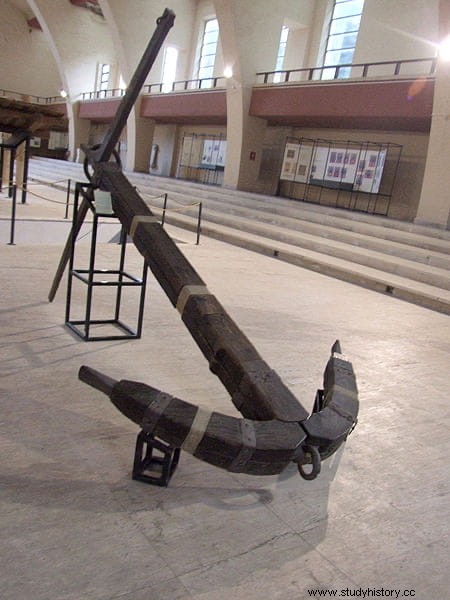
Both vessels were built following the Vitruvian model, a standard system that led to lining the live work with lead (the one that remained below the surface) leaving the polychrome dead work. While the Second Ship used human power to move (large oars of more than 11 meters in length handled from an exterior structure of the hull), the other lacked it, so it can be deduced that it was towed. They were also equipped with bilge pumps, the oldest found to date, and a plumbing system that provided hot water.
On deck they carried rotating platforms - it is believed that to display statues or perhaps to facilitate the work of cranes - that worked by means of ball bearings, something surprising for archaeologists because it was thought that this system did not begin to be used until the Renaissance. Another novelty was the use of anchors with iron staves - until then only wooden ones were used - and a design that would be widely adopted in the 19th century! It is true that similar models would be found in Pompeii and other places, showing that the Romans used them habitually.
The assassination of Caligula in 41 AD. he also condemned his ships, so that they hardly had an active life of a year. After being emptied of everything of value, including materials, they were deliberately sunk and ballasted so that they would not rise again. Or so the emperor's enemies thought; it never crossed their minds that two thousand years later someone would bring them back to the surface. It was in 1929, although local fishermen had known where the wrecks were for centuries.
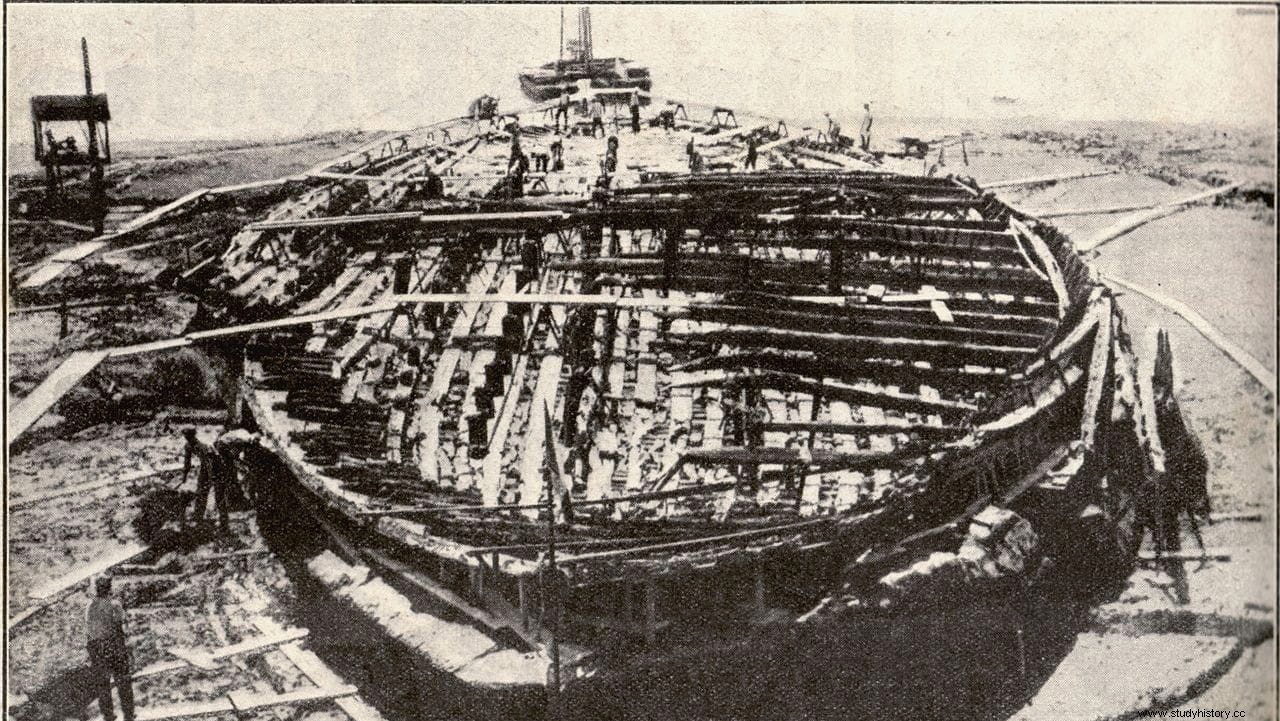
There is news of this as early as 1446, when Cardinal Colonna organized a rescue attempt that did not go well because the depth was excessive for the time (18 meters) and what he managed to do was damage the remains. A century later, another attempt was made using a diving bell and pieces such as marble, bronze and the like were removed. All this was bought by aristocrats for their collections and their trace has been lost. But the ships were still down there and there were new attempts, some private and others government.
That of the Italian Ministry of Education of 1895 rescued a bronze rudder and several carvings of the same metal with animal motifs but they were simple extractions without contextualizing. By then it had been discovered that it was not a single ship, as was thought, but two and they began to take the matter more seriously, resorting to engineers from the Regia Marina . These determined the need to drain the lake and it was what was done between 1928 and 1929 by order of Mussolini, already in power. As the level dropped, two wrecks emerged. But the lake bed began to show signs of serious deterioration and had to be refilled.

The project was resumed in 1932 and finally the two boats could be removed (plus a third small one, 10 meters long, but contemporary to the others), which were housed in a museum inaugurated ad hoc four years later. There they were on the night of May 31, 1944, when an American squadron bombarded the surroundings, occupied by the Germans, to cover the advance of the infantry. Apparently the bombs did not cause any damage, but after a couple of hours the museum caught fire without knowing why; there are those who point out that it was the Wehrmacht soldiers in their retreat, before the enemy advance.
The fire consumed the building and its contents, only saving some charred wood, bronze elements and missing pieces because, fortunately, they had been sent to Rome. In 1953 the facilities were reopened, already restored but half empty, only with what was saved, since the boats were lost. Forever? Maybe not if the so-called Diana Project goes ahead, promoted by the Dianae Lacus association. since 1995 for its reconstruction from drawings and photos.
In 2001, with the help of the Municipality of Nemi, the bow section of the Prima Nave was completed. , but the high cost seems to have put an end to the dream. Perhaps the hope is in that third ship that is eagerly sought.
